by Philip Graham
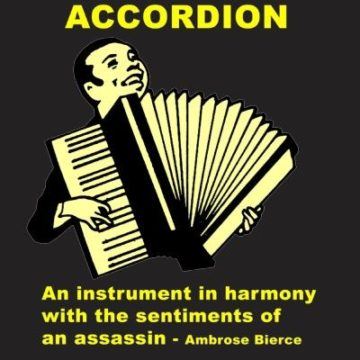 Whenever I discover a band that sports an accordion in the lineup, I’m ready to listen.
Whenever I discover a band that sports an accordion in the lineup, I’m ready to listen.
But this wasn’t always so.
It all goes back to the mid-1960s, those days of my mid-adolescence, when my father’s favorite cousin, who we called our “aunt” May, came to visit nearly every weekend. The year before, her hard-drinking brother’s liver had finally given up on him, and my father wanted to draw her closer to our family. Aunt May lived alone, unmarried and childless. As if this was a condition that needed explanation, our parents whispered to us a secret we were never to repeat aloud, that she once had a boyfriend, but he’d died in World War II and she never found another man like him.
After the ritual of a Saturday afternoon dinner, the time arrived for the ritual of settling in the living room to watch the latest installment of Aunt May’s favorite program, Lawrence Welk’s musical variety show. My younger brother and I were expected to keep her company. We, too, loved our kind and self-effacing aunt, but to my easily-affronted adolescent self, Lawrence Welk had invented his show to personally torment me. It was a kind of musical quicksand, Stepford Wives music, everything that rock and roll was trying to replace or destroy.
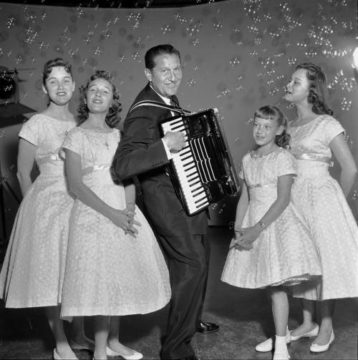 The male performers wore carefully sculpted short hair, and the women balanced bouffants sprayed into sometimes precarious place. They all looked locked in the previous decade, celebrating romantic or novelty songs from even earlier decades, with the occasional religious hymn thrown in. And everyone on stage had to smile, smile, smile, while goofy “champagne” bubbles floated above the bandstand, up toward the trademarked signage of GERITOL on the wall. As for Welk himself, he mostly held a little-used baton as he introduced each performer. Occasionally he conducted the band. Sometimes he played the accordion, a thing that looked more like a blacksmith’s bellows than a musical instrument.
The male performers wore carefully sculpted short hair, and the women balanced bouffants sprayed into sometimes precarious place. They all looked locked in the previous decade, celebrating romantic or novelty songs from even earlier decades, with the occasional religious hymn thrown in. And everyone on stage had to smile, smile, smile, while goofy “champagne” bubbles floated above the bandstand, up toward the trademarked signage of GERITOL on the wall. As for Welk himself, he mostly held a little-used baton as he introduced each performer. Occasionally he conducted the band. Sometimes he played the accordion, a thing that looked more like a blacksmith’s bellows than a musical instrument.
I sat there as long as possible before resorting to my usual I-have-to-go-to-the-bathroom excuse, and then disappeared into my room for the rest of the evening. I probably spent some of that precious alone time reading and rereading Ambrose Bierce’s The Devil’s Dictionary, which I’d discovered in a local bookstore. How could I not love, in my cynical teens, definitions such as these:
Mine, adj. Belonging to me if I can hold or seize it; or Egotist, n. A person of low taste, more interested in himself than in me.
Here was the world, stripped of its false face! Just as I had long suspected. Bierce’s judgement of the accordion—“An instrument in harmony with the sentiments of an assassin,” met my unconditional approval. The only accordions I’d ever encountered were those on the Welk show I’d just escaped, instruments of despair that, week after week, pumped out cheesy cheery polkas.
Perhaps I should have considered Bierce an unreliable narrator, because he didn’t think much of music, whatever the source. Worse, he pinned with his sardonic gaze two instruments I did love:
Piano, n. A parlor utensil for subduing the impenitent visitor. It is operated by depressing the keys of the machine and the spirits of the audience.
Fiddle, n. An instrument to tickle human ears by friction of a horse’s tail on the entrails of a cat.
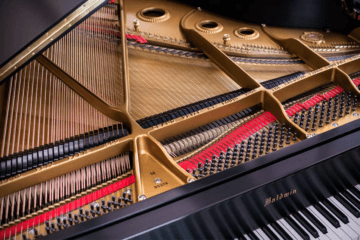 Bierce did have a point, at least concerning the peculiarity of the instruments’ physical appearance. Music can’t be seen, but the instruments that create it can be. The inside of a piano does look machine-like, something that perhaps Charlie Chaplin might get stuck in if he wasn’t careful. The violin eerily resembles a woman’s shape, with broad shoulders, thin waist and wide hips, some kind of half-human that awaits the touch of a bow to come alive.
Bierce did have a point, at least concerning the peculiarity of the instruments’ physical appearance. Music can’t be seen, but the instruments that create it can be. The inside of a piano does look machine-like, something that perhaps Charlie Chaplin might get stuck in if he wasn’t careful. The violin eerily resembles a woman’s shape, with broad shoulders, thin waist and wide hips, some kind of half-human that awaits the touch of a bow to come alive.
How did they get that way? They seem as unlikely to exist as bread. Because bread wasn’t always toast for breakfast.
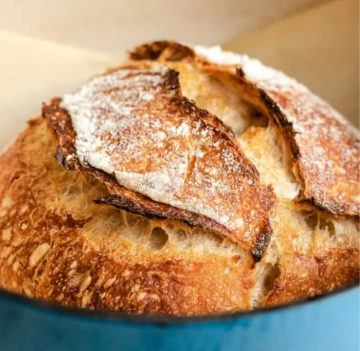 The first attempt at what would become bread was a gooey, Mesolithic porridge-like mixture of pounded grains and water. What unnamed ancestor wagered that grains of wheat might be good to eat if powdered, and then moistened? What someone else, years later or miles away, came up with the idea of heating that porridge into flatbread? And who figured out that air-borne yeast particles were just the ingredient to create something fluffier, loafier?
The first attempt at what would become bread was a gooey, Mesolithic porridge-like mixture of pounded grains and water. What unnamed ancestor wagered that grains of wheat might be good to eat if powdered, and then moistened? What someone else, years later or miles away, came up with the idea of heating that porridge into flatbread? And who figured out that air-borne yeast particles were just the ingredient to create something fluffier, loafier?
Bread satisfies an elemental hunger, so you can imagine the relentless energy that must have gone into its slo-mo metamorphosis. The joy of music (the making of it, the listening to it, the dancing to it) satisfies a deep hunger as well, so eventually a stick and a rock becomes a drum kit, and a hollowed reed sooner or later turns trumpet. And a blacksmith’s bellows—maybe?—sings itself into an accordion.
*
As years passed and memories of Lawrence Welk faded, eventually I noticed that the accordion kept popping up in my favorite music, whether it was the explorations of Pauline Oliveiros, Kimmo Pohjonen and the multi-instrumentalist Egberto Gismonti, or the sublime beauty of the Portuguese band Madredeus, the cajun stomp of zydeco or the swoony tangos of Astor Piazzolla. But I think what ultimately attracted me was the accordion’s dual identity, the inherent tension embedded in its history as it spread throughout the world.
By the mid-19th century, accordions had become Europe’s instrument of choice for dancing, because the instrument, in that era before amplified music, made a big sound, perfect for asserting itself at a noisy bar or tavern. Meanwhile, the German instrument maker Heinrich Band invented a larger version, named after himself—the bandoneon—which he hoped could serve as a portable organ: the world’s host of modest, organ-less churches was surely ready for such an instrument!
Over the years, however, the accordion’s popularity at saloons and dodgy inns brought about its periodic Sunday banishment by the Catholic hierarchy, even though the smallest churches had come to rely on the instrument to accompany and enhance the singing of hymns. Finally, at the surprisingly late date of 1943, Pope Pius XII came down on the side of accordion boosters. Apparently what tipped the balance was an Italian accordion company’s canny gift to the undecided pontiff of their deluxe model, one that proved itself capable of spectacular songs of praise to the glory of God.
So: spiritual, secular? That’s the accordion’s Heads or Tails.
*
The accordion may have been banned for a time from churches in Finland, but now the instrument enjoys so much favor that the accordionist Maria Kalaniemi was classically trained at the Sibelius Academy in Helsinki (though she has said that her true musical university “was the radio”). Kalaniemi went on to become a founding member of the groundbreaking folk ensemble Aldargaz, and now performs with a wide range of musicians around the world.
Here she plays a solo version of her song “Kuun Henki (Spirit of the Moon),” which, if not overtly religious, certainly achieves a hushed, spiritual aura. Within a circle of light focused on the bare stage, Kalaniemi’s performance seems like a private journey, so much so that the occasional cough from the unseen audiences surprises, reminding us that she is not alone.
*
The accordion was introduced to Madagascar by French missionaries in the 19th century, as the country apparently suffered from a singular lack of church organs. The accordion, however, plays no favorites. It can help you worship, whatever your spiritual calling. Before long, the instrument became important in Madagascar’s traditional trombo trance rituals. The spirits of the ancestors are believed to prefer a particular song or type of music, and the accordion fit right in.
By the age of twelve, accordionist Regis Gizavo, one of the greatest musicians of Madagascar, was accomplished enough to draw the attention of a woman possessed by a spirit. One day, when she heard him playing nearby in the village, she burst into an uncontrolled dancing. Her relatives delivered the reluctant young Gizavo to her and, though the sight of her terrified him, he managed to keep his eyes closed and play his accordion. Slowly he calmed the spirit inside her, ultimately freeing her from its grasp.
As much for career reasons as for avoiding political unrest, Gizavo spent the last three decades of his life in Paris, playing with a variety of ensembles of Malagasy and European musicians. Here Gizavo performs one of his signature compositions, “Malaso.” From the longing reflected in his voice and features, I imagine that every one of his songs, whatever its subject, may have been a song of home.
*
French missionaries also have their fingerprints on another introduction of the accordion, this time to West Africa’s Côte d’Ivoire. When musician Mamadou Ouattara was given an accordion by a Catholic priest, he quickly added it to the palate of the country’s traditional music. Years later, his sons and nephews founded Le Zagazougou, a band that has traveled far from the devotional. With an unusual lineup of the two accordions of Abou Ouatt and Moustapha Ryzo Dia, an array of percussion and two formidable female lead singers, Le Zagazougou’s dance-friendly Ivorian roots music supplanted the Caribbean Zouk music that had recently been so popular in the country.
I first heard this band during a return visit to Côte d’Ivoire in 1990, while attending a literary conference in the capital city of Abidjan. Cheap cassettes of their music played from boom boxes and radios everywhere. Le Zagazougou enjoyed an international as well as local success. In this video of their hit “Djanfa,” the band plays on the streets of a European city that appears to be Paris.
Corotoum Camara, the lead singer here, warns women to be careful, don’t be fooled by men who are only out to steal your money. To emphasize the point, the band’s playing is interspersed with a story of a young woman graced with a gold credit card who meets her cad and learns her lesson the hard way. When that cad eventually meets his comeuppance, dancing ensues with actors and musicians alike as the music fades.
*
Sophie Cavez was once one of the two accordionists in a dervish of a Belgian band, Dazibao, now gone and lamented. Cavez continues as a solo artist, performing with a rotating set of musicians she calls the KV Express.
Here Cavez performs her song, “Malone,” at the 2017 Boombal Festival. As the video proceeds and the obligatory shots of the audience accumulate, you might notice that most people are dancing in an organized manner that doesn’t much resemble the usual dance club jitters. That’s because a Boombal is a recent Belgian dance craze—a festival you attend to learn various folk dances, a skill you can then display, however awkwardly, at the nightly concerts.
It’s all in good fun, and this next—and dreamily romantic—video from Boombal 2018 features the French accordionist Aurélien Claranbaux playing a soft mazurka to slowly swirling couples, little islands of affection that fade in and out of focus. You can see why church elders suspected that an accordion playing hymns on their Sunday premises could easily become a gateway drug to close dancing for the rest of the week.
Sometimes I can’t stop replaying this video—it’s my emotional ticket to the Pandemic’s After Days, as yet unclaimed. When those days finally arrive, my wife and I plan to pack our bags for the next available Boombal.
*
I have never once touched an accordion, or a violin, or a clarinet (another favorite), or banged on a bunch of drums (though at one late-night party I dabbled at the bongos). My brief experience with a piano goes back to my pre-adolescent days, and my only guitar has been air. I’ve never come within ten yards of a pedal steel guitar, and the only nyckelharpa I’ve seen has been in photos or videos. But even absent touch, the physicality, the deep it-ness of a musical instrument fascinates me.
The young musician who narrates the following (and quite short) tutorial videos is a welcome guide to a look behind the curtains of an accordion.
I must confess, the combination of a keyboard on both left and right sides of an accordion has always made me believe that learning to play the instrument would be an enterprise of daunting complexities. All those keys! All those buttons! Yet within two minutes she demystifies that intimidating field of buttons on the left side. Not that I’d ever attempt to learn, but I can see it might be possible for someone else.
In this second video, she quite literally digs deeper, prying her accordion in two and revealing an interior reality you had probably never thought about. Who could predict the accordion’s secret of four “gigantic harmonicas” hidden within?
*
Wondering how a musical instrument creates its sound world at least promises a solution. Understanding what another person hears when listening to music is an enduring mystery. But a mystery worth considering further.
In preparing for this essay, I watched (and not without some trepidation) an entire episode of the Lawrence Welk Show, one that was first broadcast in 1968. Not a hint of that turbulent year penetrated the performances: no whiff of the Robert Kennedy or Martin Luther King Jr. assassinations, no hint that the future disgraced Nixon squeaked through to the presidency, no shadow of the Vietnam War’s continuing body count, or the civil rights protests across the land. Instead, the show opened with the regular cast dressed as hobos, peeling vegetables over a steaming pot and singing, “Put on a Happy Face.”
As the rest of the show unfolded, my choice of this episode inadvertently brought back a memory I’d nearly forgotten. One evening during that riotous year, when Aunt May was visiting we gathered together in the living room to watch the Democratic National Convention. When the Chicago police began brutally beating the protesters on the streets, suddenly Aunt May, gentle Aunt May, leaned forward in her chair and shouted, “Good, hit them, hit them harder!” Without thinking, I’d jumped up and shouted “You’re a fascist pig!”
Eventually we made up, but the rift, though a quiet one, lingered.
She’d revealed something inside her I’d never suspected, something complicated that I was too young then to begin to guess at. She’d lost the love of her life to a war, yet anti-war protesters had brought out in her a rare display of anger. Did they remind her of a pain she couldn’t touch, as if they were protesting against her man, lost to her by his service and sacrifice?
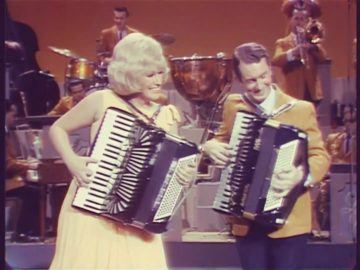 That memory wasn’t the only surprise in store for me. As the Welk episode from 1968 continued, I realized that his large ensemble of performers were actually quite talented. Many could not only sing and dance, they also played multiple instruments. I found myself enjoying their skills, though once again uncomfortable at the entertainment’s presentation. Sure, the show was thoroughly square, but the fake, ubiquitous smiles still unnerved me. Rather than revealing an inner emotional state, those smiles presented a locked door. From my own family’s attempts at public cheer I’d known just what might be hidden, and I think the sunny facade of the show might be what really drove me to my room those long-ago Saturday evenings. I’d never considered that the performers were simply working a gig. If baring their teeth in a simulacrum of happiness was the ticket to a steady paycheck, well, worse could be endured for one’s daily bread.
That memory wasn’t the only surprise in store for me. As the Welk episode from 1968 continued, I realized that his large ensemble of performers were actually quite talented. Many could not only sing and dance, they also played multiple instruments. I found myself enjoying their skills, though once again uncomfortable at the entertainment’s presentation. Sure, the show was thoroughly square, but the fake, ubiquitous smiles still unnerved me. Rather than revealing an inner emotional state, those smiles presented a locked door. From my own family’s attempts at public cheer I’d known just what might be hidden, and I think the sunny facade of the show might be what really drove me to my room those long-ago Saturday evenings. I’d never considered that the performers were simply working a gig. If baring their teeth in a simulacrum of happiness was the ticket to a steady paycheck, well, worse could be endured for one’s daily bread.
And who knows what stirred in my Aunt May? The show that scraped my teenage nerves raw seemed to soothe her. Maybe the denial of sorrow or doubt was the music that best fit her soul. Perhaps it offered her comfort to watch people holding it all together with a smile while dancing and singing. Did she admire the Best-Face-Forward ethos of the Welk musical clan, did their example help to keep her own loneliness at bay? Or could she have felt a little bittersweet sorrow at the sight of so much seemingly effortless yet unattainable happiness?
Which brings me to the Tunisian composer and oud musician Anouar Brahem, who fuses jazz with Arabic folk and classical music. In this video he has assembled a potent trio of oud, piano, and the accordion of Jean-Louis Matinier, creating an evocative chamber music possessed of an equally evocative title: “Leila au Pays du Carrousel (Leila in the Country of the Carousel).”
The song begins quietly, as if following a sad child whose day is only enlivened by a ride on a carousel. Yet as I listen, I imagine another possibility, a song about a nostalgic older woman who recalls her younger self and those days of circling with a wooden horse to the accompaniment of a calliope, when her life still embraced the joy of an amusement park ride.
There’s no forced smiling here, no smiling of any kind during this performance, and a thread of melancholy is never far away, but when the music releases itself into the carousel’s graceful whirling, I like to think that this is a song Aunt May and I might have enjoyed together.
